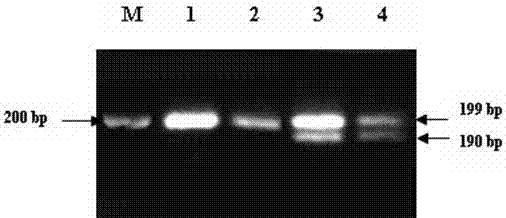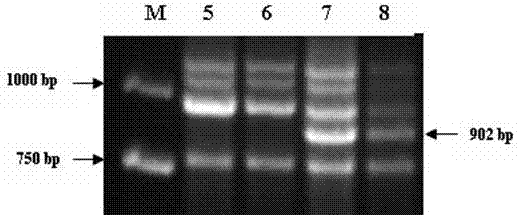A marker primer and application of wheat powdery mildew resistance gene stpk-v
A powdery mildew resistance gene and wheat powdery mildew technology, applied in the field of agricultural biology, can solve the problems of no research on marker amplification and achieve good stability
- Summary
- Abstract
- Description
- Claims
- Application Information
AI Technical Summary
Problems solved by technology
Method used
Image
Examples
Embodiment 1
[0029] Example 1 Labeled primer InDel w190 with NAU / xibao15 902 Comparative experiment in different wheat genetic materials
[0030] Using the DNA of common wheat China Spring, Ningmai No. 9, common wheat-M. w190 Primers for PCR amplification.
[0031] The PCR reaction system is 25 µL, containing 40 ng of DNA template, 5 pmol of each primer of SEQ ID NO: 1 and SEQ ID NO: 2, 1×PCR buffer, 1.5 mM MgCl 2 , 0.2 mmol dNTP, Taq DNA polymerase 1U;
[0032] The PCR reaction cycle program is: pre-denaturation at 94°C for 3min, denaturation at 94°C for 30s, annealing at 58°C for 30s, extension at 72°C for 30s, 35 cycles; extension at 72°C for 10min; storage at 4°C;
[0033] The PCR product was electrophoresed with 1% Metaphor agarose gel, the electrophoresis voltage was 100v, and the electrophoresis time was 2h. The results were as follows: figure 1 As shown, among them, lane M is the molecular weight marker, lane 1 is common wheat Chinese spring, lane 2 is Ningmai No. 9, lane 3 i...
Embodiment 2
[0035] Example 2 Labeled primer InDel w190 Analysis in the Heterochromatic System of Common Wheat-Tuviflorum 6V
[0036] Using DNA from different wheat materials as templates, InDel w190 As primers, carry out PCR amplification and electrophoresis to the wheat of common wheat-Tambulina villosa 6V heterochromatic system, the PCR reaction system and electrophoresis are the same as in Example 1, and the electrophoresis results are as follows: image 3 As shown, lane M is the molecular weight marker, lane 1 is the common wheat-P. Lane 5 is Zhengmai 883, lane 6 is 06R33, lane 7 is 06R41, lane 8 is del6VS-1, lane 9 is 92R139, lane 10 is 92R90, lane 11 is YC138-4, lane 12 is NJ4, lane 13 is YC24 , lane 14 is NJ1-15, and lane 15 is YC146-4; the results show that the specific band with a size of 190bp and 199bp band, while only a 199bp band could be amplified in common wheat China spring, which is susceptible to powdery mildew.
Embodiment 3
[0038] Labeled Primer InDel w190 F hybridization of Ningmai 9 with the wheat-T. villosa 6VS small fragment translocation line YC72-2 2 Validation in generation plants
[0039] Take the F of Ningmai No. 9 × YC72-2 2 18 plants in the generation population and the DNA of 2 parents are used as templates for PCR amplification, and the PCR reaction system and electrophoresis are the same as in Example 1, and the electrophoresis results are as follows: Figure 4 As shown, where M is the molecular weight marker, lane 1 is the parent YC72-2, lane 2 is the parent Ningmai No. 9, and lanes 3-20 are F 2 Generation plants, F in lanes 5, 6, 10, 11, 13, 14, 15, 16, 17, 18, 20 2Specific bands of 190bp and 199bp were amplified from the generation plants and the parent YC72-2 of lane 1, which were resistant to powdery mildew. F 2 Only 199bp band was amplified in Ningmai 9, the single plant of the generation and the parent of Lane 2, which was a plant susceptible to powdery mildew.
PUM
 Login to View More
Login to View More Abstract
Description
Claims
Application Information
 Login to View More
Login to View More - R&D
- Intellectual Property
- Life Sciences
- Materials
- Tech Scout
- Unparalleled Data Quality
- Higher Quality Content
- 60% Fewer Hallucinations
Browse by: Latest US Patents, China's latest patents, Technical Efficacy Thesaurus, Application Domain, Technology Topic, Popular Technical Reports.
© 2025 PatSnap. All rights reserved.Legal|Privacy policy|Modern Slavery Act Transparency Statement|Sitemap|About US| Contact US: help@patsnap.com



